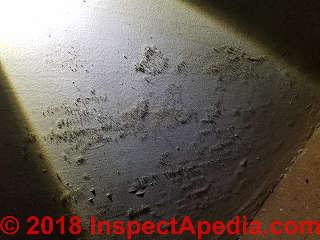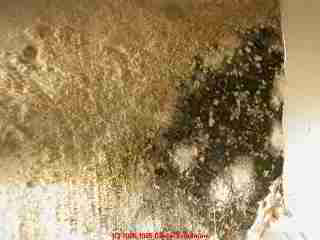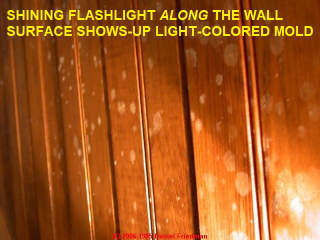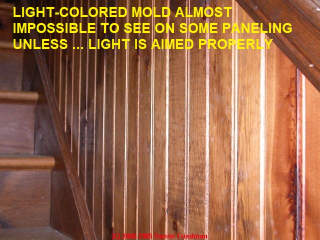 Use Light to Find Mold & Other Surface Contaminants
Use Light to Find Mold & Other Surface Contaminants
Find hidden or hard-to see light colored mold contamination in buildings
- POST a QUESTION or COMMENT about using lighting as an aid during building investigations
How to use a flashlight or other light to spot building contaminants on surfaces. The fact that mold is "hidden" or hard to spot on some surfaces in buildings does not mean you cannot find it.
While this is perfectly obvious to some folks, too many of us haven't considered that is you don't know exactly how to aim your flashlight you won't see important, possibly toxic, light-colored molds or other contaminants in buildings.
This article describes how to make proper use of the level of light and light-aim or direction of light to find light-colored particles such as some harmful molds that may be on light-colored surfaces. The same procedure can also spot hard-to-see dark-colored particles on dark surfaces.
This careful inspection of building surfaces can help assess the chances of a significant mold reservoir in buildings, and will help the investigator decide which of these building areas, walls, ceilings, etc. need more invasive inspection and testing.
Page top photo: extensive mold contamination (probably Aspergillus sp.) on this basement drywall in a New York home becomes very apparent when our flashlight is aimed parallel to the wall.
InspectAPedia tolerates no conflicts of interest. We have no relationship with advertisers, products, or services discussed at this website.
- Daniel Friedman, Publisher/Editor/Author - See WHO ARE WE?
Mold Detection Flashlight: Use proper lighting to find mold contamination in buildings
 Proper use of and aiming of light or a flashlight when looking for mold in buildings can make the difference between
seeing and missing what might be the most important mold reservoirs in a given structure.
Proper use of and aiming of light or a flashlight when looking for mold in buildings can make the difference between
seeing and missing what might be the most important mold reservoirs in a given structure.
Like the Purloined letter problem mold may be in plain sight but may be hard to see, until you know how to look.
One result is that people who are testing mold often collect the "easy to see" mold but perhaps not the most important mold in a building. Here's how to do it right - in this brief article.
In most cases, proper use of a flashlight can help spot mold on paneling and other building surfaces.
How and where you shine light is of crucial importance when looking for mold in buildings.
Light-colored mold such as some members of the Aspergillus sp. and Penicillium sp. groups are often the dominant problem-mold in buildings but these offenders are often missed by a casual inspection because they can be hard to see on surfaces.
You need a bright flashlight and you need to know how to use it. As we will explain, it is critical that you shine your inspection light along the surface being examined, not straight at it.
As you'll see in the mold photographs shown here, using your light carefully can make a big difference in what mold you find and where you find it. Just looking for "black mold" risks missing the important mold in a building.
Light colored mold next to obvious black mold
Aiming a bright flashlight along this wall surface where dark mold was obvious shows a light gray/green fungal colony which in fact was far more toxic
and thus important to select as an additional source for surface sampling using adhesive tape.
How and where you shine light is of crucial importance when looking for mold in buildings.
Light-colored mold such as some members of the Aspergillus sp. and Penicillium sp. groups are often the dominant problem-mold in buildings but these offenders are often missed by a casual inspection because they can be hard to see on surfaces.
You need a bright flashlight and as simple as this seems, you need to know how to use it.
Shine the flashlight along the surface being examined, not straight at the surface. If you shine the light directly at the surface being inspected you may not see a thing. As you'll see in the mold photographs shown here, using your light carefully can make a big difference in what mold you find and where you find it.
We inspect for any mold growing on building surfaces.
White, gray, light green, red, yellow, or other colored-molds may be allergenic or toxic.
Looking only for "black mold" touted in the popular press risks missing the most important mold in a building.
 Some black molds such as the Ceratocystis/Ophistoma group are simply
cosmetic.
Some black molds such as the Ceratocystis/Ophistoma group are simply
cosmetic.
Other toxic black molds such as Stachybotrys chartarum are rarely airborne unless mechanically disturbed such as by demolition.
These "toxic black molds", especially if the genera/species are heavy, sticky, not-normally-airborne mold spores (Stachybotrys chartarum is an example) may actually affect building occupants less than highly-airborne but small, light-colored, hard to see mold spores such as members of the Aspergillus sp. family.
Finally, finding any mold growing on building surfaces is an indicator of mold-friendly conditions and means, in turn, that other non-black but still highly-toxic or allergenic problem mold genera/species might be present.
So it's usually reasonable to interpret any mold we see in a building as evidence of mold-conducive conditions which may, in turn, justify further investigation.
Light colored toxic mold on paneling can be hard to see in ordinary lighting and requires careful inspection.
But notice how the lighting shows that this paneling is buckled. I'd suspect that it has been exposed to high moisture if not water, and that there is risk of hidden mold on the cavity side of this material.
This is a case in which the careful use of light shows not mold but rather undulations in the wall paneling surface which in turn means moisture and mold risk.
Further inspection was needed - an inspection of the hidden side of paneling, drywall, and the wall cavity.
We did not actually find mold inside this wall - which goes to show that where there's moisture there is not always a mold problem. But the evidence merited looking for mold.
Light colored toxic mold on paneling is not visible
because light is being shone directly onto the wainscot wood paneling surface.
Aiming a light or flashlight at roughly right angles to a surface means most of the light rays bouncing back to your eye are coming off
that surface at the same angle - the light will have trouble showing the profile or edges of light-colored or other small particles.
So you may have trouble seeing contaminants on a building surface even though your light source is very bright.
Now try shining a light along the surface - this easily shows the white mold colony.
 The angle of illumination along the sides of small particles shows their presence more easily than in the direct-illumination example just above.
The angle of illumination along the sides of small particles shows their presence more easily than in the direct-illumination example just above.
Aiming
a light or flashlight along the surface means that some of the light rays are bounced off of the profiles or sides of small particles
on that surface, making them easier to see. I'm simplifying the physics of light a bit but you can see the point of these illustrations of finding
hard-to-spot light colored mold on a building surface.
Even dust, or any other surface irregularities show up better with this method of
inspection. we have used this method of oblique light direction to spot drywall nails as a quick way to find a wall stud when hanging a picture.)
When we work in the forensic laboratory with a microscope, we use both transmitted and angular reflected light to examine small particles as different information is provided by each method.
The point of these illustrations of using light to help look for mold in buildings is to demonstrate that "hidden mold", like the purloined letter, may in fact be hiding in plain view - you just don't know how to see it.
"Toxic" Black Mold Hazards
Watch out: For years popular news articles have made some people terrified at the mere mention of "toxic black mold" such as "Stachybotrys chartarum." And while we agree that mold contamination needs to be removed, panic, too, is bad for both your health and your wallet.
Actually it is common to find Stachybotrys chartarum in small amounts in houses where there has been prolonged leakage or water entry. It's a toxic mold that should be removed.
But don't assume that anything and everything black on a building wall is a highly toxic mold. Some black stuff is not mold at all. Other common mold species look black but may be of low or no toxicity.
For example, Chaetomium globosum™has been reported to be allergenic rather than toxic.
Cladosporium sphaerospermum is often found growing indoors on bathroom tile or refrigerator gaskets. It's a member of the most common mold family, Cladosporium, the "universal fungus." It can look pretty "black" on some surfaces.
Harmful Light-Colored Molds
Still other light-colored molds such as in the Aspergillis or Penicillium families are serious pathogens that can cause very serious illness. But they can be hard to spot on a surface.
Can you tell what genera or species a mold is that's growing on a surface just by the naked eye? No. Though I've inspected and tested so many molds on so many surfaces that like a bird watcher, I know what's likely to be present in a given habitat.
(Refrigerator gasket mold is usually a Cladosporium, often C. sphaerospermum and mold growing on window muntins will be a genera/species tolerant of UV light. A normal person can't do this.
Do You Need to Test Mold to Identify It?
Knowing the mold genera/species dosn't change the action needed: remove the mold, clean the surfaces, fix its cause.
We do not usually need to know the mold genera simply to do a mold cleanup. But there are some medical and technical reasons why we might want to identify the dominant mold genera/species in a building before starting a mold clean-up job.
You cannot determine the mold genera and species just by looking at it on the wall, and please skip those do-it-yourself mold test kits. The methods the kits use are fundamentally inaccurate and in a few cases so are their laboratories.
Small Mold Cleanup Doesn't Need Testing Nor a Mold Remediation Company
For small mold problems, spend your money on some soap and water instead.
For larger mold contamination problems (more than 30 square feet) you should hire an expert to survey your home, or send your own mold sample to a competent testing laboratory. The services of an experienced mycologist or aerobiologist are necessary to know what you've got. ©DJF Copyright protection trap. ©Daniel Friedman
Reasons to occasionally test for and identify mold are explained
More examples of how light can make hard-to-see mold contamination show up are
Another example of use of oblique lighting to find building defects is illustrated
...
Continue reading at LIGHT, GUIDE to FORENSIC USE or select a topic from the closely-related articles below, or see the complete ARTICLE INDEX.
Or see these
Recommended Articles
- FIND MOLD, ESSENTIAL STEPS - home
- FORENSIC INVESTIGATION of BUILDINGS - home
- HIDDEN MOLD, HOW TO FIND
- LIGHT AIM FINDS MOLD & OTHER PARTICLES
- LIGHT, GUIDE to FORENSIC USE
- STAIN DIAGNOSIS on BUILDING EXTERIORS
- STAIN DIAGNOSIS on BUILDING INTERIORS
- THERMOGRAPHY IR Infra Red
- THERMAL SCANNERS
- UV LIGHT BLACK LIGHT USES
- VISUAL PERCEPTION ERRORS
- WHITE MOLD PHOTOS
Suggested citation for this web page
LIGHT AIM FINDS MOLD & OTHER PARTICLES at InspectApedia.com - online encyclopedia of building & environmental inspection, testing, diagnosis, repair, & problem prevention advice.
Or see this
INDEX to RELATED ARTICLES: ARTICLE INDEX to BUILDING FORENSICS
Or use the SEARCH BOX found below to Ask a Question or Search InspectApedia
Or see
INDEX to RELATED ARTICLES: ARTICLE INDEX to BUILDING ENVIRONMENT
Or use the SEARCH BOX found below to Ask a Question or Search InspectApedia
Or see
INDEX to RELATED ARTICLES: ARTICLE INDEX to BUILDING INDOOR AIR QUALITY IAQ
Or use the SEARCH BOX found below to Ask a Question or Search InspectApedia
Or see
INDEX to RELATED ARTICLES: ARTICLE INDEX to MOLD CONTAMINATION & REMEDIATION
Or use the SEARCH BOX found below to Ask a Question or Search InspectApedia
Ask a Question or Search InspectApedia
Questions & answers or comments about using lighting as an aid during building investigations.
Try the search box just below, or if you prefer, post a question or comment in the Comments box below and we will respond promptly.
Search the InspectApedia website
Note: appearance of your Comment below may be delayed: if your comment contains an image, photograph, web link, or text that looks to the software as if it might be a web link, your posting will appear after it has been approved by a moderator. Apologies for the delay.
Only one image can be added per comment but you can post as many comments, and therefore images, as you like.
You will not receive a notification when a response to your question has been posted.
Please bookmark this page to make it easy for you to check back for our response.
IF above you see "Comment Form is loading comments..." then COMMENT BOX - countable.ca / bawkbox.com IS NOT WORKING.
In any case you are welcome to send an email directly to us at InspectApedia.com at editor@inspectApedia.com
We'll reply to you directly. Please help us help you by noting, in your email, the URL of the InspectApedia page where you wanted to comment.
Citations & References
In addition to any citations in the article above, a full list is available on request.
- In addition to citations & references found in this article, see the research citations given at the end of the related articles found at our suggested
CONTINUE READING or RECOMMENDED ARTICLES.
- Carson, Dunlop & Associates Ltd., 120 Carlton Street Suite 407, Toronto ON M5A 4K2. Tel: (416) 964-9415 1-800-268-7070 Email: info@carsondunlop.com. Alan Carson is a past president of ASHI, the American Society of Home Inspectors.
Thanks to Alan Carson and Bob Dunlop, for permission for InspectAPedia to use text excerpts from The HOME REFERENCE BOOK - the Encyclopedia of Homes and to use illustrations from The ILLUSTRATED HOME .
Carson Dunlop Associates provides extensive home inspection education and report writing material. In gratitude we provide links to tsome Carson Dunlop Associates products and services.


